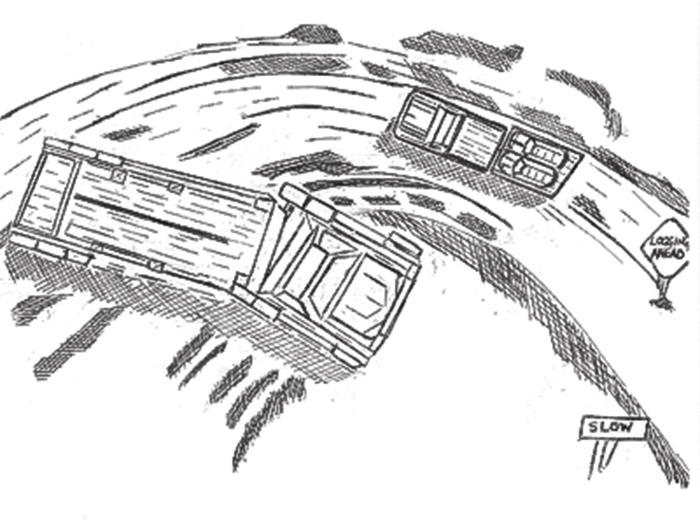 BACKGROUND: On a clear and sunny March day in the Lake States, two U.S. Forest Service employees were returning to their duty station, driving a pickup truck on a county portion of a forest road. The pickup was towing a trailer with two snowmobiles on board. The gravel road surface had patches of snow and ice.
BACKGROUND: On a clear and sunny March day in the Lake States, two U.S. Forest Service employees were returning to their duty station, driving a pickup truck on a county portion of a forest road. The pickup was towing a trailer with two snowmobiles on board. The gravel road surface had patches of snow and ice.
PERSONAL CHARACTERISTICS: The drivers of the two vehicles had many years of experience driving on woods roads, and in Lake States weather conditions.
ACCIDENT: At approximately 2:45 PM, as the Forest Service personnel approached a curve on a flat roadway, an empty log truck appeared, heading in their direction. The log truck, operated by an independent owner/operator, began to skid and the truck trailer “jack-knifed.”
The driver of the Forest Service vehicle slowed, moved to the side of the road and stopped. Due to the presence of a snow bank, he could not move the vehicle and trailer completely off the roadway.
After bouncing off the snow bank on the opposite side of the road from the Forest Service vehicle, the log truck slid into the driver’s side of the Forest Service pickup, and continued around the corner, coming to a stop approximately 250 feet past the pickup.
The impact of the log truck pushed the Forest Service vehicle into the snow bank on the passenger side. The collision was sufficient to cause the air bags in the Forest Service vehicle to deploy. The two snowmobiles broke free of their secured mounts on the trailer, and one landed in the roadside ditch approximately 40 feet beyond the trailer.
INJURY: None of the three people involved was injured. The damage to the Forest Service pickup and snowmobiles exceeded their value. The log truck also sustained major damage; its rear axle was bent back at a 30º angle, rendering the vehicle inoperable. Additional damage occurred to the log truck’s wheel in front of the rear axle.
UNSAFE ACT OR CONDITION: County law enforcement and state commercial enforcement determined that the incident was a “no fault” accident.
Travel on roads during the winter months presents numerous hazards. The two primary hazards present when this accident occurred:
Road surface conditions were characterized as intermittent patches of snow, ice and gravel; daily vehicle traffic.
RECOMMENDATIONS FOR CORRECTION: Ensure all vehicles entering the road have a Citizen’s Band (CB) radio broadcast to the same frequency, and that they communicate when traveling in and out. (The log truck driver had used a CB to broadcast that he was exciting the road, but the Forest Service vehicle did not have the frequency in use by the truck driver and did not hear the message.)
A sign had been posted at the entrance to the road indicating log trucks were hauling on the road.
The particular corner was also signed ‘slow,’ using white paint on a damaged red fender hanging on a tree in the middle of the corner.
Supplied by Forest Resources Assn.
